Mental health app development is a popular technology trend for 2023 and continues to gain popularity. The rapid digitalization of healthcare has allowed for the expansion of eHealth products, making it possible to handle sensitive doctor-patient interactions online. If you’re interested in improving people’s psychological well-being while running a successful online business, this editorial will provide valuable guidance on developing a mental health app without making rookie mistakes.
Why Mental Health App Development is Gaining Momentum
Software for mental health issues didn’t just appear suddenly. Online consultations by therapists have been available for years. However, it wasn’t initially well-received. People generally prefer to stick to what they know, especially when it comes to their health, so it was difficult to trust in a new and innovative solution.
But now, the creation of mental health apps is in high demand and can be quite lucrative. There are various factors that contribute to this, and many of them go beyond just technological progress. Let’s explore the four key elements and how they affect the market.
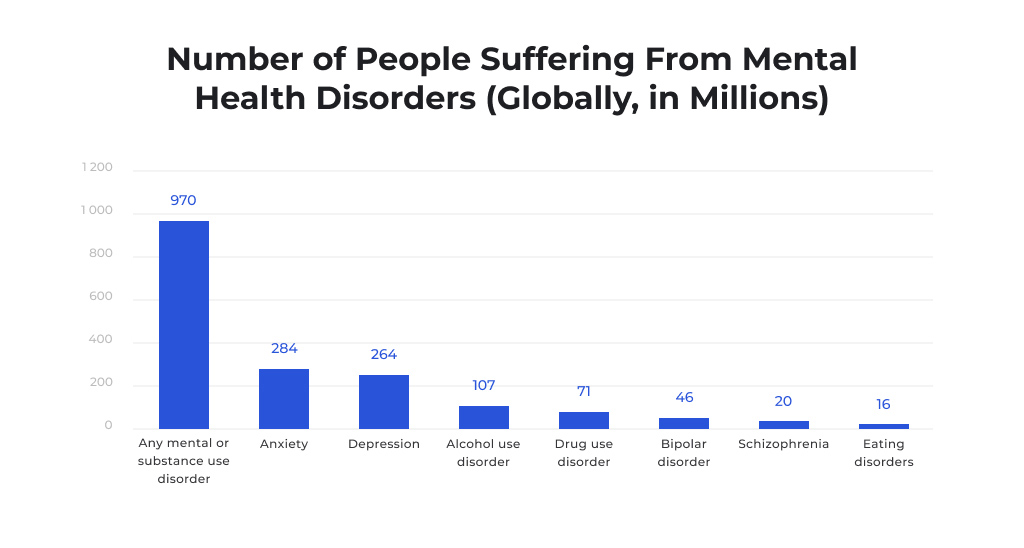
Direct Demand
The destigmatization process has finally begun, and we are witnessing progress with small yet significant changes. More individuals are actively seeking ways to manage their psychological well-being. One of the most popular steps towards this is downloading an app that can provide assistance.
How many individuals can actually benefit from this? According to a report by Statista, it is estimated to be around ⅛ of the population. This represents the approximate number of people who have experienced substance use or mental disorders in their lives.
Enhanced Flexibility
Mental health app development offers entrepreneurs ample freedom to take action. The range of software that can be developed and embraced by users is remarkable. Some opt to invest in online counseling platforms, while others choose to leverage telemedicine or create unique solutions like meditation or animal therapy apps.
From reminders for medication to tools for tracking moods, from journaling aids to self-care guides, this software comes in various forms. Business owners entering this market need not fret about everything already being accomplished. This niche market is far from saturated.
Approval from Society
Mental health app development is not considered a profitable pursuit by the general public. This is because these apps are designed to address specific problems, enhance quality of life, and can even save lives for some users.
Additionally, it is important to note that society disapproves of the authorities’ lack of concern and vigilance. In the US in 2022, 58% of respondents believed that federal investment in mental health was insufficient. There is a clear divergence of interests between the people and those in power. Mental health app development offers a solution to a problem that affects everyone, but those in power do not see its value if it is not directly linked to social or economic well-being.
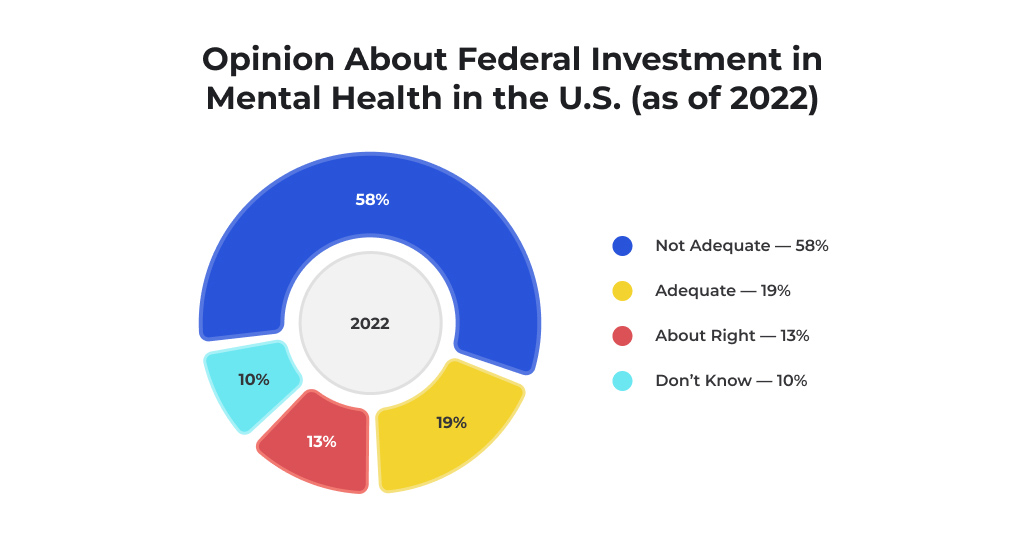
Effortless Market Entry
The amount of people who own PCs, tablets, or smartphones and use the internet is increasing every day. It’s easy to reach a large international audience for apps that aim to improve mental health, as long as the software is translated into multiple languages.
Industry-Specific Trends: A Reality Check
To create a successful mental health app, it is crucial to consider the current market and future trends. By analyzing the industry’s potential growth, you can ensure your app’s success. In 2024, there are five significant trends that will influence this sector.
Companies Investing Heavily in Employee Satisfaction
Mental health issues lead to reduced productivity, decreased performance, and shorter attention spans. In 2024, employers are anticipated to start prioritizing this matter.
Mental health app development benefits C-level executives, management, employees, venturers, and developers. It’s not just about making more money from productive and satisfied staff. It also creates a positive atmosphere within the organization and encourages the development of unique and user-friendly wellness-related digital products.
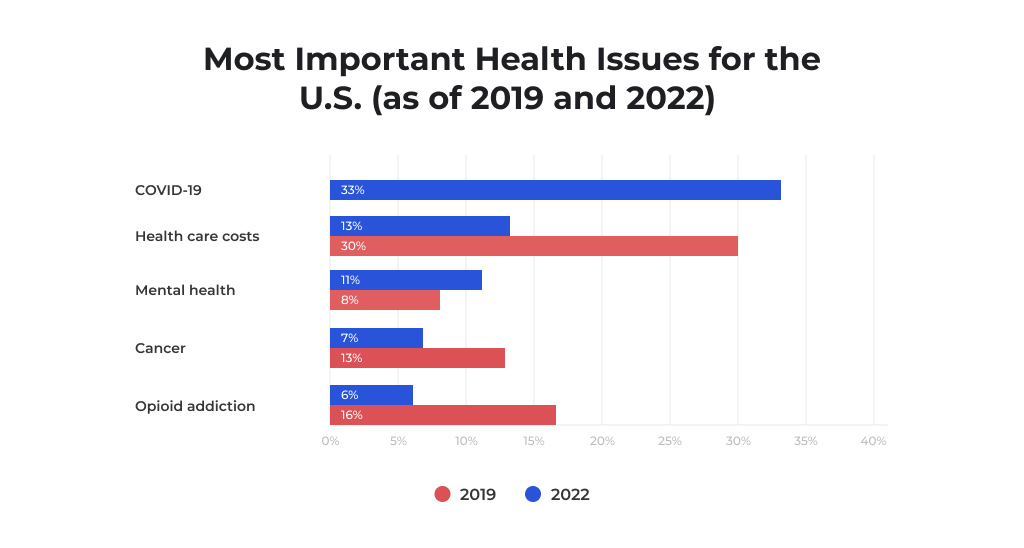
The Future of Alternative Treatments
Despite the need for accessible and affordable therapy, many people around the world lack access to medical care. This imbalance has led to the rise of unconventional treatment methods, such as psychedelic and art therapy, Ayurveda, and others. As a result, there is a growing demand for alternative ways to improve mental health.
Responding to Young People’s Cries for Attention
Developing a mental health app for youth requires considering specific comprehension and mood patterns, attention-holding techniques, and gamification. Although it is currently not a popular topic, it is expected to change soon.
Telepsychiatry: The Future of Mental Health Care
Online counseling through telepsychiatry is now easily accessible through various devices, thanks to the advancements in telemedicine. The demand for this service remains high even after the pandemic, making it a lucrative market for entrepreneurs to explore in 2023. Customers are willing to pay for these solutions, making it a promising opportunity for business growth.
Digitalization of Post-COVID Struggles Settlement
Check out the graph that shows the increase in people experiencing anxiety symptoms between April and September 2022. These mental health struggles, such as angst, burnout, anhedonia, and tearfulness, have become more prevalent due to the prolonged period of isolation we have had to endure. Unfortunately, they are often not taken seriously enough.
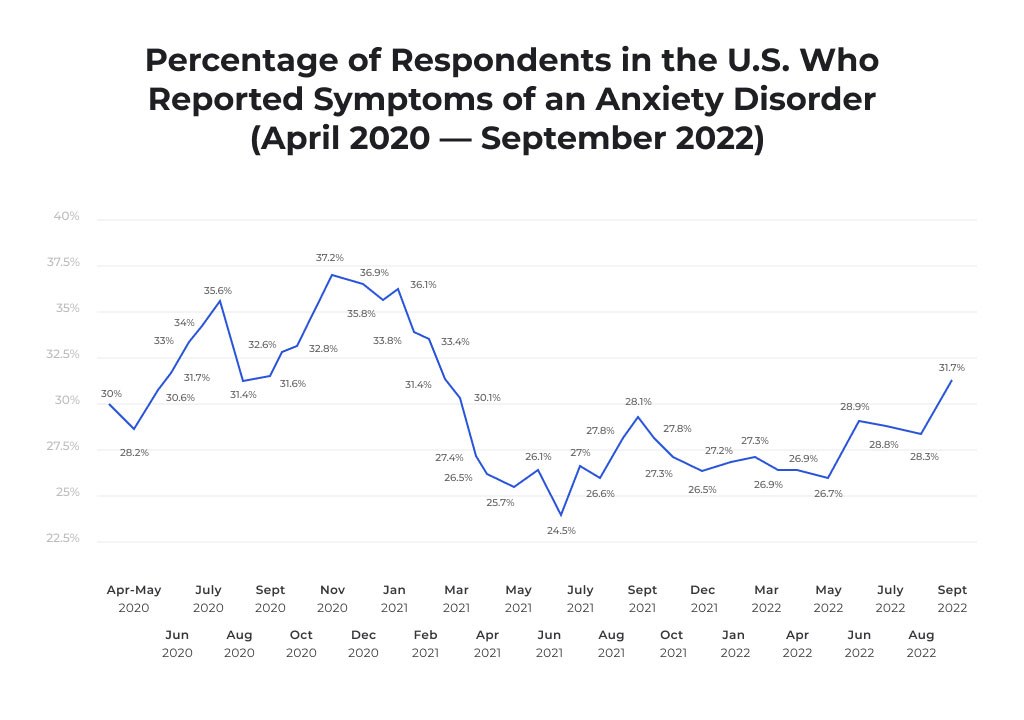
In the final week of September, the number of respondents was nearly equal to the high levels seen in the previous months of autumn 2020, with percentages of 31.7% and 37.2%. Depression symptoms indicate a sluggish development.

Mental Health App Development: Opportunities for Innovation
Developers of mental health apps have the ability to create almost anything. If you have an idea, concept, or theory, you can test it out by creating software. Therefore, it’s not surprising to see different approaches to determining types of mental health apps in various sources. To simplify things, this editorial presents five groups of applications based on the type of content or service they provide.
Mental Disorder Apps
These solutions are designed for individuals with specific diagnoses such as depression, OCD, PTSD, eating disorders, bipolar disorder, schizophrenia, ADHD, and more. These apps offer helpful tools to address their issues, including specialized consultations from experts in the field.
Common features of a mental disorder app include round-the-clock medical support, tools for managing stress, a repository of knowledge, a calendar to track symptoms and mood, and additional functionalities.
Apps for Improving Mental Well-being
Many individuals without a diagnosed disorder or illness experience symptoms they want to alleviate, such as stress, mood swings, frustration, anxiety, and sleep problems. Self-improvement solutions can assist users in monitoring and enhancing their psychological well-being without the need for unscheduled sessions.
These software applications serve as excellent digital assistants for those who wish to establish and maintain a personalized care routine. The apps help users develop habits more quickly, reach their goals, aid in addiction recovery, and provide step-by-step methods for improving alertness, among other benefits.

Versatile Mental Health Applications
This is a popular type of application that many people find useful. If there is an app that can provide answers to questions, offer consultations, allow for ordering or purchasing medications, and do it all in one place, people will definitely use it.
These solutions bring together individuals with specific mental health conditions and those who need other types of medical help or are seeking counseling services for their loved ones.
Most multipurpose medical apps are web-based, although there are some exceptions where a mobile version can also be created.
Telehealth Platforms
Telemedicine has rapidly gained popularity, and it’s no surprise why. Who wouldn’t want to have access to their doctor whenever they need it? Initially, telemedicine focused solely on physical health, but it has since expanded to include mental health services.
This type of solution can assist with launching therapy sessions through voice, video, or text, selecting a qualified mental health professional online, and managing scheduling, payments, and medications. Telemedicine software can be implemented in various medical settings, such as individual practices, hospitals, and correctional facilities, with customized functionality to meet the needs of each customer.
Apps for Women’s Well-being
What factors contribute to the popularity of women-focused apps compared to those for men? Several factors come into play.
- Firstly, there are numerous health conditions that exclusively affect women, beyond just reproductive health concerns.
- Secondly, women tend to be more open about their mental health struggles and actively seek out solutions to manage them.
- Thirdly, historically, women’s health has been overlooked, creating a market niche that is still ripe for new players, particularly in developing economies.
The category of “women’s well-being apps” encompasses a wide range of solutions, including:
- Pregnancy journals
- Mood and fertility trackers
- Birth control assistants
- Female-only online communities
- Hygiene apps
- Breastfeeding apps
- Fitness solutions
This type of software is often referred to as FemTech, similar to Fintech or EdTech.
Mental Health App Development Checklist for 2024
Now, let’s move on to the most challenging but crucial step – creating the application. In this section, you will discover helpful guidelines to simplify and streamline the entire process for business owners. What features should be included in the app? How can it be monetized? What compliance challenges should be anticipated? It’s time to figure all of that out!
Mandatory Features
Every digital solution should have a set of features that are essential for both healthcare mobile app development and healthcare web development. Business owners should keep in mind that users expect these features to be present in any app or website.
Sign Up/Sign In
Healthcare software implies a certain level of confidentiality, ergo, users should be able to get access to certain application features after completing a registration/log in process.
According to the solution specifics, there may be several options:
– User name + password
– Phone number + SMS password
– Phone number + automated call
However, it’s vital to keep the registration short. Do not burden new users with in-depth forms and questionnaires. If the registration is complicated or too long, the user won’t stay, which means deleting the app or completely forgetting about it.
Password reset and recovery mustn’t be eliminated. The user should be able to get access to their account no matter what and do it without putting much effort into the process.
User Profile
After completing the registration process, it is necessary for the user to disclose precise information regarding their health. While some may find this intrusive, having knowledge about the patient’s medical conditions, allergies, habits, therapy experiences, and current medications is of utmost importance.
Undoubtedly, the ideal structure of the user profile will depend on the type of solution and the perspective of the business owner. However, prioritizing personalization, convenience, and clarity should always be paramount.
Calendar/Symptoms Tracker
This is typically the central component of a mental health app. Prior to or during the development of the app, careful consideration should be given to providing users with a convenient self-monitoring tool. This tool may take the form of a symptom calendar, a journal, a tag system, a sleep or fitness tracker that syncs with an external device, or other options. The customer should thoroughly contemplate and select a specific type of self-monitoring functionality that aligns with the expectations of the target audience.
For instance, a mood tracker designed for children should prioritize user-friendliness, while adults may be able to handle a more intricate tag system or a digital journal.
Notification Updates
Ensure the development of a mental health application that truly benefits users by implementing a thorough notifications and reminders system for both patients and doctors. Utilize push notifications for web and mobile platforms to keep users engaged and motivated on a daily basis. Additionally, medical professionals should receive notifications whenever a user requests to connect or schedule an appointment.
Chat/Messaging Platform
To ensure a basic digital solution for mental health concerns, it is recommended to include a communication tool such as a live chat or messaging system. This is especially beneficial in comprehensive applications, as it provides a secure platform for medical professionals and patients to communicate. Additionally, in simpler solutions, it allows users to easily resolve any issues by connecting with a support team member.
All of the features listed above are mandatory for a successful mental health app. However, there are many additional features that you may want to consider, such as:
- Order management tool
- Payment gateway
- Social media integration
- Rating system
- Gamification
- Media files upload/download
- Dashboards for doctors and admins
- Support groups and forums
Whether or not to include these optional features will depend on the specific needs of your app and its target audience.
Ways to Generate Revenue from an Application
The selection of a monetization strategy should be made by the business owner prior to the completion of the mental health app development process. This is crucial as the revenue model has a direct impact on the application, including its design and features. For instance, if the intention is to incorporate in-app purchases, it is essential to inform the mental health app developers beforehand. The same principle applies to other monetization strategies. Let us now explore the most prevalent ones.
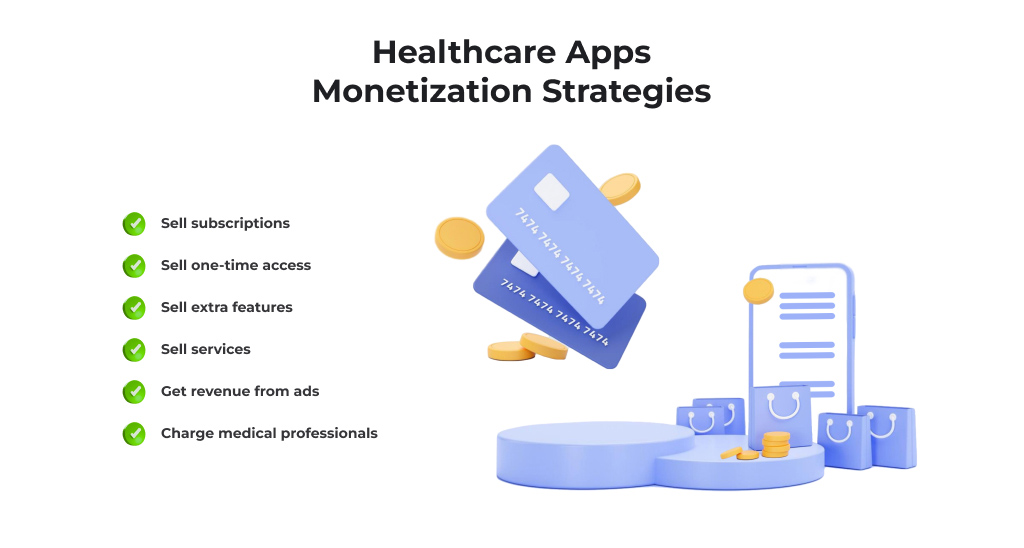
Subscription Sales
The implementation involves providing the user with exclusive content or functionalities that are not accessible to other users. These may include a designated number of personalized consultations with a preferred expert, valuable media resources such as videos, podcasts, and a comprehensive library, round-the-clock assistance from a dedicated manager or therapist, and various additional attributes.
The determination of the subscription plans, their pricing, and the content they offer lies within the discretion of the business owner.
Offer a One-time Subscription
An entrepreneur establishes a price for the app, and the user purchases it to gain access. Nevertheless, the owner must ensure that the software possesses genuine value, is beneficial, and operates seamlessly. With numerous free apps available, customers should perceive the worth in a product they have invested in.
Offer premium features
This approach, commonly referred to as freemium, entails providing users with complimentary content while requiring payments for a range of premium features. Additionally, some opt to allow access to the complete version for a designated duration, after which payment becomes necessary.
Charge for your services
An ideal solution for private practitioners is to engage mental health app developers, establish a user-friendly digital platform, and market their services effectively.
Maximize Ad Revenue
If content monetization is not your preference, you can generate revenue by integrating advertising into the app. However, despite being a widely used monetization strategy, it is essential for a business owner to carefully oversee the advertisements and collaborate exclusively with reputable advertisers to ensure the well-being of the audience.
Medical Professionals’ Fees
One effective strategy to entice users to your app without jeopardizing their loyalty is to charge doctors instead of patients. By doing so, medical professionals on your platform will bear the financial responsibility, leaving users free to enjoy the benefits of your app.
Choosing a Technology Stack
To enhance the process of developing a mental health app, it is crucial to consider the appropriate tech stack. However, it is important to note that there is no one-size-fits-all solution that can cater to every business case. To make an informed decision, it is advisable to conduct multiple meetings with various mental health app developers and attentively consider their perspectives.
Simultaneously, it is essential to familiarize oneself with certain aspects to ensure a more seamless interaction with technology experts.
1. The app’s tech stack and platform determine the necessary technologies for web and mobile apps.
2. Advanced features like AI, ML, and VR require expertise in NLTK, Flow.AI, TensorFlow, ARKit, and similar technologies.
3. The tech stack choice impacts the budget, but mental health app developers can suggest cost-effective alternatives.
Now, as for the technical tools used to create an application, let’s list the most popular ones.
- For back-end: Python, PHP or PHP frameworks (Laravel, Symfony, etc.,) Ruby on Rails
- For front-end: JavaScript, HTML/CSS, TypeScript, React.JS, Angular
- For mobile apps: React Native, Swift, Flutter, Ionic
- Databases: MySQL, Maria, PostgreSQL, Mongo
- Cloud: AWS, Azure, Google Cloud
- Payment Gateway: Stripe, Skrill, Paypal
Industry Compliance Management
One of the main challenges for business owners in developing a mental health app is ensuring compliance. This is crucial because patients trust providers with sensitive personal and medical data, so it is essential to adhere to modern data protection standards.
Different countries have specific regulations and acts that govern the protection of sensitive information. For instance, in the US, there are HIPAA, HITECH Act, CCPA, and others. In Canada, it’s PIPEDA, in Japan—APPI, and in the EU, it’s GDPR. While these acts share similarities in outlining obligations for healthcare providers handling sensitive information, they also have varying requirements.
Once a target market is defined, business owners should familiarize themselves with the regulations in that country and find mental health app developers who not only know how to develop the app but also how to ensure compliance. In fact, during the interview process, questions about compliance should be prioritized. Additionally, you can refer to our HIPAA compliance checklist for an overview of what to expect.
Perfect Design Solution
Typically, graphic design is an integral part of the development process, allowing entrepreneurs to exercise their creative freedom and implement innovative ideas. However, when it comes to mental health app development, this norm does not apply.
To ensure that your design effectively represents your brand and caters to the needs of your audience, consider the following recommendations:
– Avoid using special effects such as flashing lights or loud sounds, as these can be triggering for users.
– Refrain from excessive use of animation or decorative fonts, as they may hinder the absorption of information.
– Opt for pastel or muted colors instead of bright ones, particularly neons.
– Select soothing nature sounds for audio elements.
– Limit the use of colors to no more than 3-4, and restrict the number of fonts to 2.
– Keep the design simple and coherent.
It is important to remember that finding a therapist can be a challenging, exhausting, and costly process. Therefore, the design of your app should provide customers with a sense of relief, uplift their spirits, and instill hope and optimism. While mental health app developers invest their energy, expertise, and effort into building the product itself, your role as a business owner is to collaborate with the design team and establish an appropriate visual style.
Now that you have gained an overall understanding of how to create a mental health app, let us delve into the topic of pricing.
Cost of Developing a Mental Health App
If you are currently perusing this editorial, it is likely that the pricing of mental health app development is a significant worry for you. For numerous entrepreneurs, this aspect holds greater importance than possessing the knowledge of how to actually create a mental health app. Therefore, let us delve straight into the matter at hand.
To put it succinctly, the cost may vary between USD 40,000 and USD 250,000. Now, let us ascertain the specific position of your app within this range.
Several factors contribute to the ultimate price, which we will briefly outline.
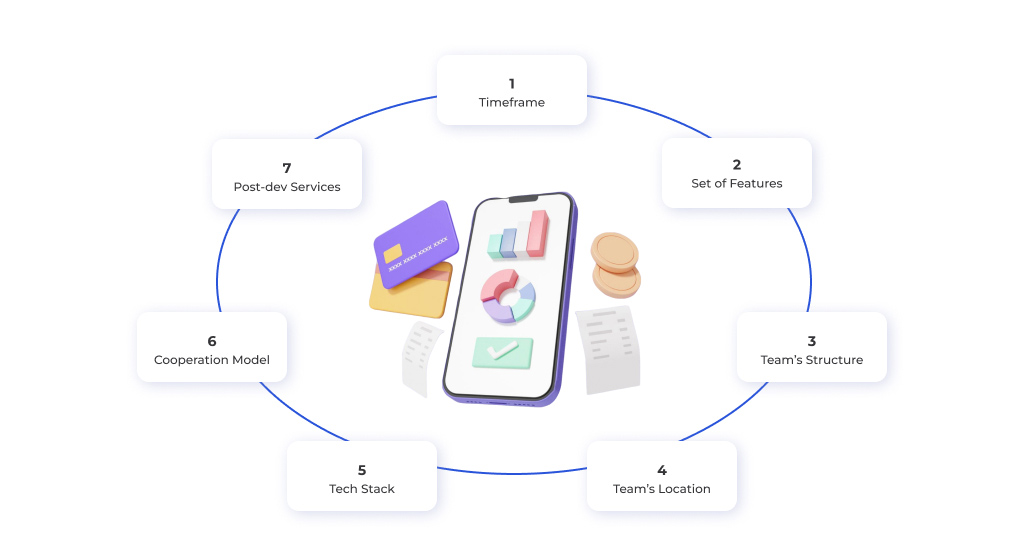
Timeframe
If the customer has time constraints and needs a solution that is ready for the market within a specific timeframe, the cost will generally be higher. The shorter the deadline, the greater the expense, as the development team will need to work extra hours or engage additional experts to meet the deadline. Consequently, if cost reduction is a priority, it may be advisable to consider developing a mental health app without the need to compress the entire process into a tight schedule.
Feature List
The number of features planned for implementation is not the sole consideration. The complexity of the features and their compatibility within the system are crucial factors. Hence, entrepreneurs often opt for an MVP when developing mental health apps to gain insights into market outlook, audience feedback, and the most suitable market strategy.
Team Organization
Consider the number and level of expertise of the professionals you wish to engage. While there are countless developers capable of creating a mental health application, entrusting the project to an individual with no prior experience in healthcare-related projects is unlikely.
While it is possible to hire a team of seasoned experts, this may come at a significant cost. Therefore, it is important to strike a balance. Consult with your selected IT vendor to determine the most appropriate solution, as a reputable company will be able to provide suitable options.
Team Location
Startup founders often hesitate to entrust the development of mental health applications to IT service providers located outside their own country. This apprehension is justified as it often leads to excessive expenses. To illustrate, let’s consider the United States. The average cost of software development in the US ranges from USD 100 to USD 150 per hour. In contrast, Vietnam offers an average hourly rate that is four times lower. Therefore, if cost reduction is a priority, it is advisable to select a development team situated in a country renowned for its outsourcing capabilities.
Technology stack
There are numerous technology experts available who possess extensive expertise in the most widely used information technology tools. However, as a general guideline, opting for more specialized or less commonly utilized technological resources in your repertoire will result in an increased cost.
Collaborative model
To save costs, it is advisable to choose either a dedicated team or a time and materials (T&M) model. The former entails paying solely for the IT services rendered, while the latter includes additional expenses such as sick leaves and vacations for the employees.
Post-development services
After developing a functional mental health app, it is crucial for business owners to consider how to maintain its competitiveness. This can be achieved through a variety of post-development services, such as regular updates, security checks, troubleshooting, and performance enhancements. However, these services require financial investment. It is important to assess which tasks can be handled in-house and which ones need to be outsourced.
Closing Remarks
It is essential to consider various factors and address potential issues when developing a functional, visually appealing, effective, and commercially successful mental health app. STDIO ASIA takes pride in its expertise in creating such apps and offers assistance with a wide range of healthcare-related IT tasks. This includes developing new apps, improving existing solutions, designing captivating interfaces, and ensuring the highest quality of digital products.
We trust that this article has provided valuable insights into the process of creating a mental health app. If you have any further inquiries, please do not hesitate to contact us for a complimentary consultation. Our expert will be delighted to address all of your questions.



Leave a Reply